Menu
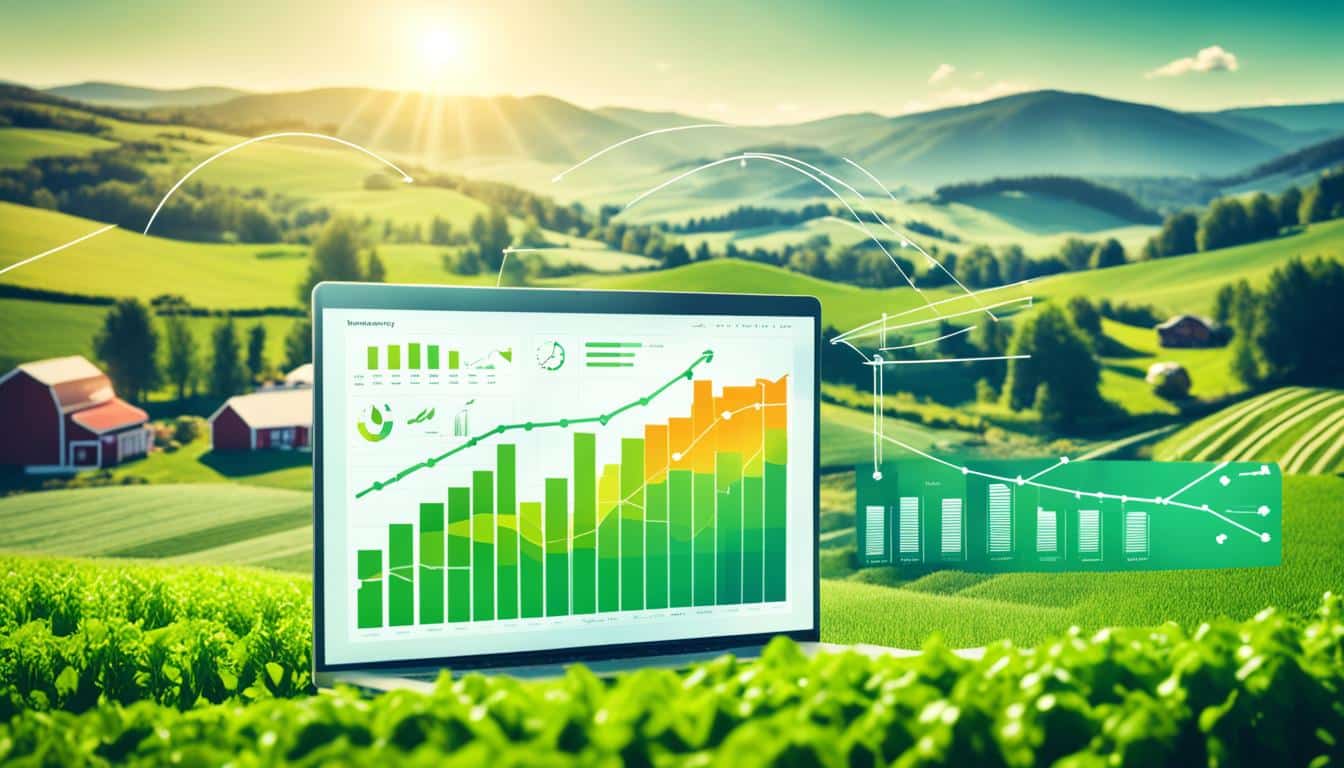
AgFunder stated that investment in AgriTech reached a massive $17 billion in 2018. This marked a 43% increase from the year before. It shows how data analytics are changing farming. Dr. Benie K. M., the CEO of Farmsell, says using data has given the industry a big boost. It helps people in agriculture make better decisions, be more productive, and earn more money.
Analytics in farm marketing are all about using current data for better choices. This data includes weather trends, buying patterns, and what’s happening in the market. It helps in figuring out where products are needed and how to sell more. By using this info, farming becomes more successful.
Data analytics has changed modern agriculture, making it more efficient. It gives farmers important information quickly. This helps them make better decisions and improve how they manage their crops.
Agricultural data analysis helps farmers decide smarter. They use information on the weather, market trends, and what consumers want. Predictive analytics guides them in spending resources better, managing risks, and how to connect with markets.
Using data helps farmers know the health of their crops, the current weather, and what the markets are doing. This leads to better planting and selling times. It also means more productivity and making more money.
Data analysis and new farming tech help manage crops better. Things like sensors, drones, and better machinery are changing how farming works. They help with planting, watering, and keeping pests away.
Farmers use data from many places to make choices throughout the year. They pick the best crops, water them at the right times, and control pests. This helps them get more out of their land while using fewer resources.
Using data also cuts down on waste and makes farming more effective. It’s a key change as the world will need a lot more food by 2050. Plus, with better data, farming does less harm to the planet.
“The farm management software and data analytics market is projected to grow with a CAGR of 17.47 percent from 2021 to 2026, underlining the immense potential and importance of data analytics in modern agriculture.” – Statista
Even with its benefits, we must also think about keeping data safe. Strong encryption, limit access, and follow privacy rules to protect farmers’ important information.
Data analytics really is transforming farming. As tech gets even better, farming will keep improving. This will make agriculture more efficient, productive, and kinder to the planet.
Farm marketing analytics is crucial for modern-day agriculture. It changes how we look at market trends and what consumers want. This data-driven approach is key in facing today’s competitive market. The agricultural trade evolution has benefited a lot from this approach.
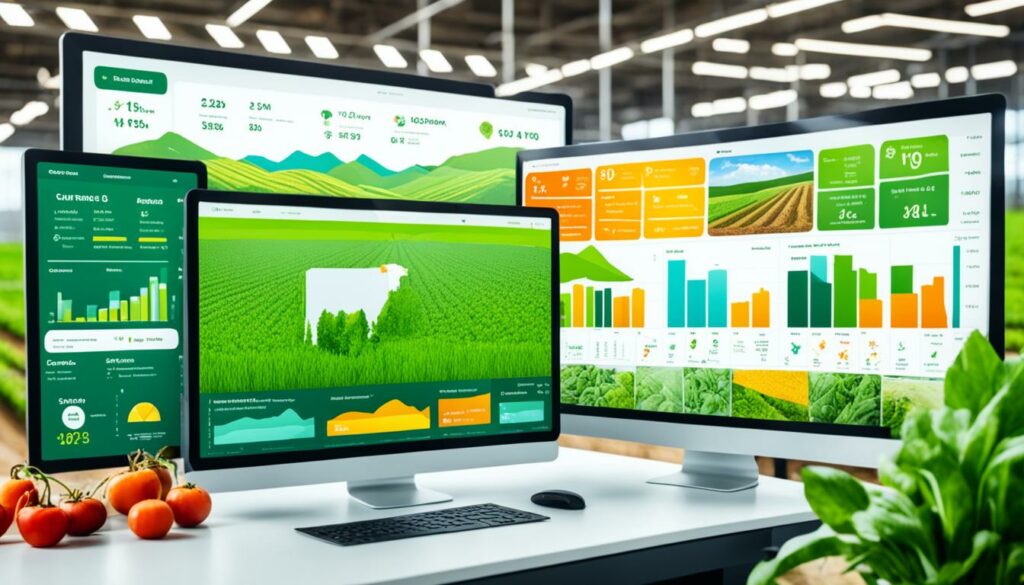
Farm marketing analytics means using data science to make better decisions in farming. It uses data from sensors, satellites, and market reports. This helps farmers and others in the sector understand market changes. It leads to better predictions of what the market will need. This, in turn, helps in using resources wisely. It also supports the growth of AgriTech companies.
The agricultural trade evolution shows us a journey from basic trade to modern data models. Initially, farming was just based on what people knew and simple surveys. But, the use of technology has changed everything. Now, digital tools give us instant updates on crops, weather, and markets. This change has made farming more precise, efficient, and sustainable.
| Year | Technology Advancement | Impact |
|---|---|---|
| 1990s | Manual Data Logging | Basic trend analysis and record-keeping |
| 2000s | Introduction of Digital Platforms | Beginner-level digital data collection |
| 2010s | Integration of IoT & Sensors | Enhanced real-time monitoring and resource allocation |
| 2020s | Advanced Data Analytics | Comprehensive market trend forecasting and precision agriculture |
Using agricultural data analysis changes how farming works. It boosts the farm’s production and protects the environment. This is done by making decisions based on collected facts. This way, farmers can use their resources better, know what the market wants, and grow more crops.
A key gain of analysing farm data is using resources better. For example, precision farming uses satellite images and weather predictions. This helps farmers manage fields more precisely, which increases crops and cuts waste. By understanding how to use resources wisely and the effects on the environment, farming gets more efficient. These data-driven methods can save a lot of money globally, up to $164 billion, by using resources well.
Farmers can also foresee market needs through data. Looking at past data helps spot upcoming problems like pests or bad weather. This early warning lets farmers prepare ahead of time. It also helps in preparing the right amount of food so there is less waste, and food gets to where it’s needed efficiently.
| Aspect | Benefit |
|---|---|
| Field Management | Enhanced crop yields, reduced waste |
| Risk Mitigation | Anticipate pest/disease issues, adverse weather |
| Supply Chain | Optimized logistics, efficient produce distribution |
| Sustainability | Lower ecological footprint, improved efficiency |
Using big data and AI in farming is a big change. These technologies make farming more precise with smart watering and keeping an eye on crops. They also lead to machines that can work on their own, saving money and making farms more efficient. With the growing market in data analytics, going from $1.4 billion in 2023 to $2.5 billion by 2028, at a rate of 13.1%, it’s clear these changes are important for the future of farming.
Rural marketing insights can boost farm profits significantly. Customised reports and dashboards offer key data on how to improve production, manage risks, and understand market needs. These insights help farmers make better decisions, leading to increased profits.
The Indian rural sector consists of over 600,000 villages, where 72% of the population lives. Most of these villages are small, with under 5,000 people. For businesses, especially in farming, it’s critical to work effectively in these low-density areas. They face challenges like hard-to-reach places and high inventory costs. Through rural marketing insights, businesses can solve these problems. They learn to use resources better and find smarter transport solutions. This can raise the money farmers make from their crops.
One big issue in rural areas is the lack of good roads. Bad roads mean slower travel and trouble reaching some places. This makes selling products harder. But, by using data to plan ahead for these challenges, farmers can improve their shipping strategies. They ensure their products get to customers on time while spending less money. So, using these insights in farming can really increase the money farmers earn.
| Challenges | Solutions through Rural Marketing Insights |
|---|---|
| Low Population Density | Enhanced inventory management and strategic sales point locations |
| Poor Transportation Infrastructure | Optimised logistics and distribution planning |
| High Inventory and Transportation Costs | Cost reduction through improved efficiency and data-driven decisions |
| Impassable Village Roads | Development of alternative access strategies |
For farmers, using rural marketing insights is key to improving how they grow crops. It helps them work better with market changes. By adopting these insights, they can make more money and become stronger financially. This supports the long-term success and growth of their farms.
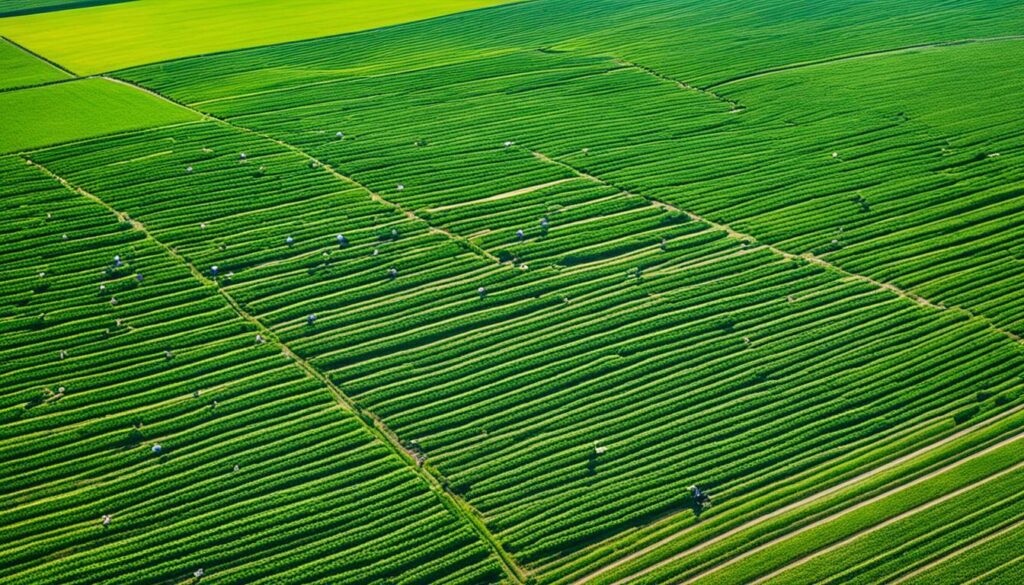
In the fast-changing world of agriculture, using agribusiness metrics is key. They help farmers make smarter marketing choices. Knowing and using these metrics can improve how farms work and where they sit in the market.
Agribusiness metrics are great for seeing how well a farm is doing. For example, the asset turnover ratio shows how good farm assets are at making money. A high ratio means the farm is using its assets well. It’s also important to track how much product a farm is making. This shows if the farm is using its resources well.
| Metric | Description | Importance |
|---|---|---|
| Asset Turnover Ratio | Measures the effectiveness of assets in generating revenue. | Higher ratios signify improved asset utilisation. |
| Wages to Revenue Ratio | Indicates how effectively labour resources are utilised. | Assists in balancing labour costs and farm profitability. |
| Debt over Assets Ratio | Evaluates farm management and operational risk exposure. | Critical for understanding financial health and risk. |
| Working Capital | Should be 30% for crop farms and 20% for animal farms. | Ensures financial stability. |
Identifying market segments is critical too. It helps farmers find the best areas to focus their marketing. They look at data on what people want to buy. This lets them tweak how they sell their crops and animals. Keeping an eye on pricing helps make smart choices on what to grow and raise.
Additionally, metrics on workers show how to make the most of the farm team. They cover finding and growing talent, and keeping workers happy. This is crucial since a large part of the world works in agriculture. Knowing about the people side helps keep farming strong worldwide.
Using these metrics in marketing doesn’t just help farms work better. It also gets their products to the right people in the best way.
Farm management software is key for modern agriculture to perform at its best. It makes collecting data, managing fields, and controlling inventory much easier. This enables a more efficient farming practice.
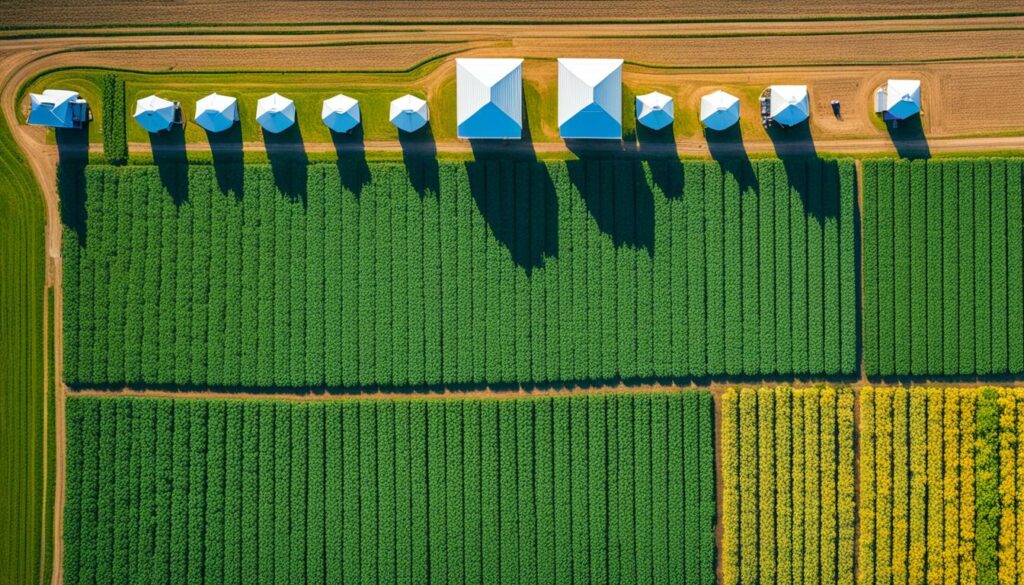
The market for Agriculture Management Software will reach USD XX.X billion by 2031. This will be a result of an XX.X% growth per year. Digital agriculture solutions are pivotal for this development. They give farmers instant access to important data. This helps in making better decisions to improve their farms’ efficiency and impact.
The Agriculture Management Software Market considers regions like North America, Europe, India, China, Japan, and MEA. Studying these areas is important for understanding how to apply farm management software worldwide.
Although the cost to start using these solutions can be high, their benefits are clear. They help the environment by promoting eco-friendly practices. Yet, they face challenges from other tech and market issues like material shortages. Even so, the value of these solutions in managing resources efficiently and running operations smoothly is significant.
| Indicators | 2023 | 2031 |
|---|---|---|
| Market Size (USD Billion) | XX.X | XX.X |
| CAGR | XX.X% | |
Precision agriculture analytics help farmers boost their crop yields. They do this by using data to make smart farming decisions. Drones, soil sensors, and IoT devices supply the data needed for better choices.
Precision agriculture is about getting the most out of crops without hurting nature. It relies on tools like GPS and satellite imagery. This approach lets farmers treat their fields in specific ways. DJI Agriculture and the Smart Farming Team are leaders in providing these tools.
Collecting good data is key to precision agriculture’s success. Things like soil sampling and drones help gather this data. Then, high-tech software helps turn it into useful information. This info can help spot problems early, like pests or bad weather.
These analytics also help prevent big issues like machine failure. This saves money and time for farmers, making their work smoother. For farmers like Bryan Bowen and John Glick, these tools have made a big difference.
Overall, precision agriculture analytics are changing farming for the better. They give farmers real-time data to make their fields work best. As more farmers use these techniques, farming gets more productive and friendly to the environment.
In today’s farming world, knowing what customers want is key to success. This makes them more interested and brings more profits.
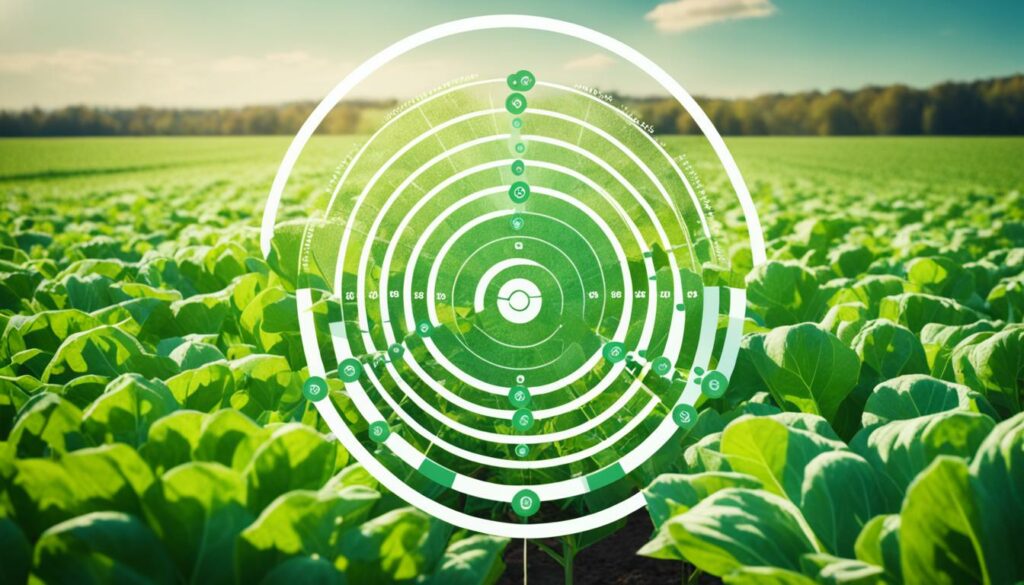
It’s important to know your customers well. By using data, businesses can learn about who their customers are and what they like.
For example, they can find out about their age, income, and education. This helps to send messages that really speak to them.
Tailoring messages can stop consumers feeling irritated. Most people (90%) don’t like messages from businesses that don’t apply to them.
So, it’s critical to make personal farm marketing messages for each group. Ads that target certain behaviours are more effective than general ones.
Looking into what people like and might buy helps create messages that suit them. Also, working with influencers and having advice systems can help reach more people, keeping them engaged and loyal.
By doing all this, farming companies can do well in a competitive world. They can make customers happy, engaged, and loyal.
Marketing local produce well means showing how it goes from farm to table. Today, people like to know where their food comes from. Being able to see this journey can make people trust your produce more. It also makes them think it’s fresher and better quality.
Using the term ‘farm-to-table’ isn’t just trendy; it’s a smart way to interest customers in local, sustainable food. Talking about the quality and freshness of your produce can really attract buyers. Sites like Instagram and Facebook are perfect for telling the story of your produce, from the farm right to the table.
Being active in the community helps people care more about local produce. You can do this by organising special market days or cooking events. Working with local chefs or restaurants can also get your products noticed.
Offering loyalty programs and discounts can make customers come back. But, remember to also involve schools. Trips to the farm can get kids interested in where their food comes from.
Keeping an up-to-date website with product info helps people stay connected. Your website can also have events info. This all helps to keep your community informed.
Don’t forget to ask for feedback from customers. This info is crucial for making your local produce marketing even better. It helps you check if your efforts are working well.
By using these strategies, you can not only sell more local produce but also support local farms. This strengthens your community and helps local agriculture grow.
Data-driven approaches have changed how farms market their products, leading to great successes. This article shows how the use of data can boost farm profits, help with managing resources, and improve marketing strategies.
AgFunder reported a substantial $17 billion investment in AgriTech in 2018. This shows a 43% year-over-year increase. More analytics means more advances in agriculture.

One case study looks at using big data to improve crop yields. By using data, farming forecasts and resource use have become better. It’s said that using data can help save up to $2.3 trillion in food and farming problems.
AI and data analytics are also saving a lot of money in farming every year. About $250 billion of these yearly savings come from these technologies. And the analytics market in AgriTech is expected to hit $1,236 million by 2023.
| Metrics | 2018 | 2023 (Projected) |
|---|---|---|
| AgriTech Analytics Market Value | $585 million | $1,236 million |
| Investment in AgriTech | $17 billion | – |
| Potential Savings from Data-Driven Approaches | $2.3 trillion | – |
Data science and big data are becoming more common in farming. This shows how the industry is moving more towards using data. Real-time data on crops, weather, and markets is being used to make better decisions with Farm Management Systems (FMS).
Another study focuses on a big global farming business. It used data analytics to reduce food waste by 20% to 30%. By 2030, this could save them $155–405 billion. This not only saves money but also helps the environment, showing that data use in farming has many benefits.
When picking tools for farm marketing analytics, match them with your farm’s goals. Agribusiness experts advise looking at what the tools can do. They should also work well with your current systems. Farming changes quickly and what you grow can go off. So, getting the right data is key.
The right agri-tech tools can really change how you make marketing decisions. These tools help collect data from your farm using things like sensors and cameras. They also work with software that makes managing your farm easier.
For example, they let you guess what people might want to buy and set the best prices. This is key for doing better in the market.
A strong Marketing Information System (MIS) makes smart choices backed up by solid facts. It gives you important and accurate information. This helps your marketing plans fit what’s happening now. So, these tools aren’t just for making choices. They’re for making things better. They help you get to know your customers and pick the best ways to sell your products.
Here are some things to think about when choosing the tools:
Tools like ClimateAi, FarmLogs, and Trimble Ag Software bring a lot to the table. They offer many useful features. Whether you’re planning for the future, dealing with the weather, tracking growth, or sorting out your budget, there’s a tool for you. Choosing the right one means knowing what each tool can do and finding what fits your farm best.
Data-driven marketing in agriculture comes with hurdles. These include getting the data, dealing with poor tech setups, and learning new digital tools. To beat these, farmers must know how to gather agricultural data and use tech solutions well.

Getting good data from farms is key for marketing success. But, bad weather and lack of good internet often get in the way. This means it’s hard to make the most of smart planting, watering, and battling pests. Farmers need to pick top-notch data tools and ways to collect info. This helps to grow more food while using fewer resources.
There are also tech hurdles to jump over in data-driven marketing. Facing these means putting money into things like cloud tech and gadgets that connect things to the internet. These tools tell you how the crops are doing, what the weather’s like, and what the market wants. Teaching people how to use these techs is just as important. Solving these issues helps farmers use tech to make their farms greener, more productive, and more money-making.
The future of farming is changing fast. New technologies are helping to shape it. Nearly 80% of farms worldwide are using high-tech tools like GPS and drones. This is just the start of a big change.
AI and machine learning are leading the way in emerging agrotechnologies. They can use a lot of data to predict things. This includes weather, pests, and what the market will need. With help from biotech, we might even get crops that can handle different climates. The future of farming looks bright and very different.
These new technologies will have a huge impact over time. By 2050, global warming might make it harder to grow crops. But, AI and machine learning could help lessen this drop by better managing resources and keeping a close eye on crops. Nearly all agribusinesses think having one place to get important data is crucial.
These changes aim to make farming better for the planet. Right now, farming can harm the soil and water, and hurt many insect species. Using data smartly can help fix these problems. It promises a greener future for agriculture.
Data analytics is changing farming by using tons of info from places like satellite images and soil sensors. This data is turning into precision agriculture. This approach manages fields better, cutting down waste and hiking crop yields. So, farmers can run their farms smarter.
Using old data, predictive analytics can guess at what’s to come for crops and conditions. This lets farmers get ready ahead of time against pests, diseases, and bad weather. It also helps boost crop growth with the right conditions and the newest tech, such as drone pictures.
Data analysis is great for eco-friendly farming, too. By looking at how we use resources and the environment, we can farm greener. It even helps with the whole farming supply chain, making everything from moving goods to predicting what people want smoother. This cuts down on wasted food and gets fresh goods to customers.
Big data is big for the future of farming, helping in genetic studies, fighting crop diseases, and making new farming tech. AI and machine learning are changing farming by doing things like watching crops and guessing what might happen next. These techs help boost farm business and keep farms going strong over time.
Yet, fitting data analytics into farming faces some challenges. Making data open to all farmers and linking data from different places are key to everyone using this tech. It means we need to work hard, invest in tech, and teach people how to use it. By using analytics well, anyone in farming can push the industry forward and make their farms better.
Farm marketing strategies boost agricultural business outcomes. They use data-driven methods to improve productivity, profit, and reach in the market.
Data analytics in agriculture helps make better decisions. It gives insights on weather, market trends, and what consumers do, leading to better operations and higher yields.
Farm marketing analytics use data for better decisions in agriculture. This means knowing what’s popular in the market, what people prefer, and improving how products get to market.
Over time, analytics grew from simple reviews to smart models forecasting what the market needs. This improvement was mainly because of better technology.
The benefits are many. It helps use resources better, predict market trends, reduce waste, save money, and farm more productively by changing how people farm using data.
Insights from rural marketing let farmers improve how they make products, handle risks, and meet what the market wants. This can lead to more money and financial strength.
Using agribusiness metrics shows how well a farm is doing. It helps find the best market areas and plan better marketing. This improves how well a farm does in the market.
Farm management software makes running a farm smoother. It looks after data, fields, and what’s in storage. This makes decisions more on point.
With precision agriculture, farmers use data from things like drones and soil sensors. They use this to grow more accurately and productively.
By learning a lot about who buys their products, farmers can speak to them better. They make marketing that’s more personal, making customers happier and more loyal.
Good marketing can show where food comes from, have special market days, show cooking, and work with restaurants. This highlights how fresh and eco-friendly local products are.
Some cases show how analytics found chances in the market, made products better, and formed good partnerships. These helped in marketing well.
Farmers must think about what they want to achieve, how they collect data, if it fits with their current systems, and if it’s easy to use. This ensures they get helpful insights for better farming.
Problems can include trouble getting data and dealing with new technology. The answers are to invest in better systems, learn about data, and use things like cloud computing and the Internet of Things.
New tech like AI, machine learning, and better biotech look to make farming more productive, eco-friendly, and flexible. This suggests a bright future for farming’s innovation.